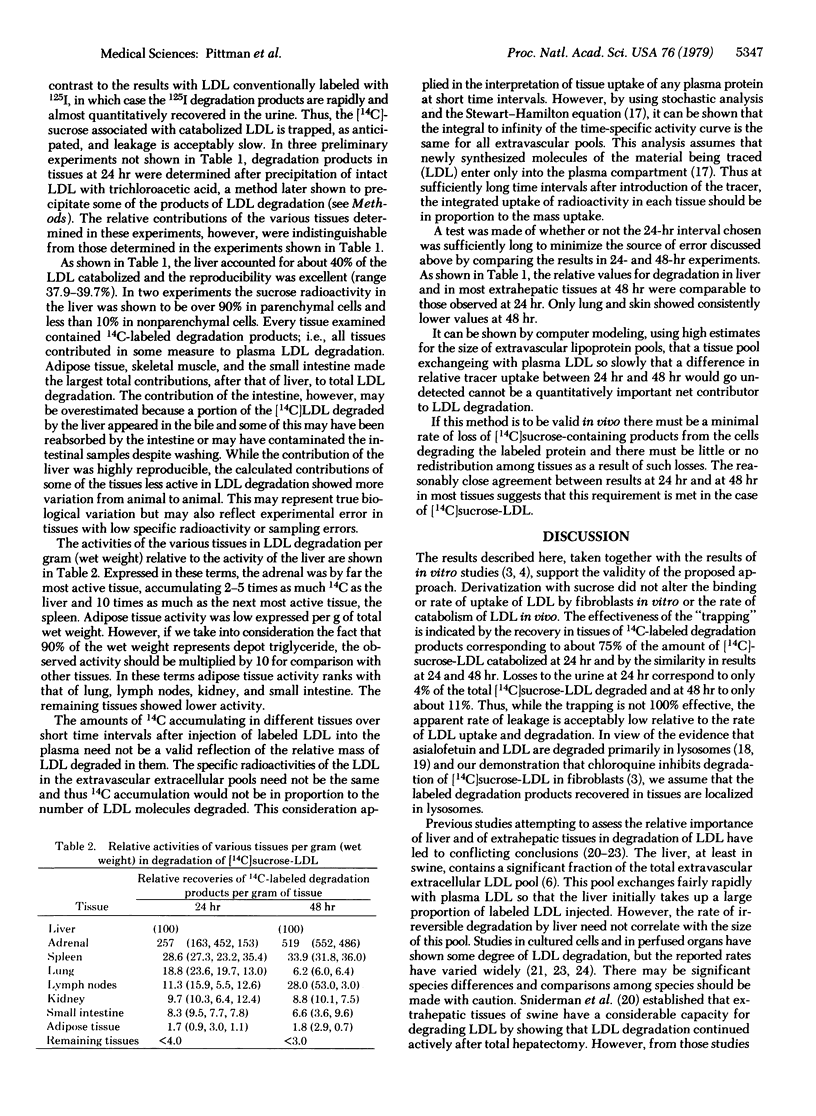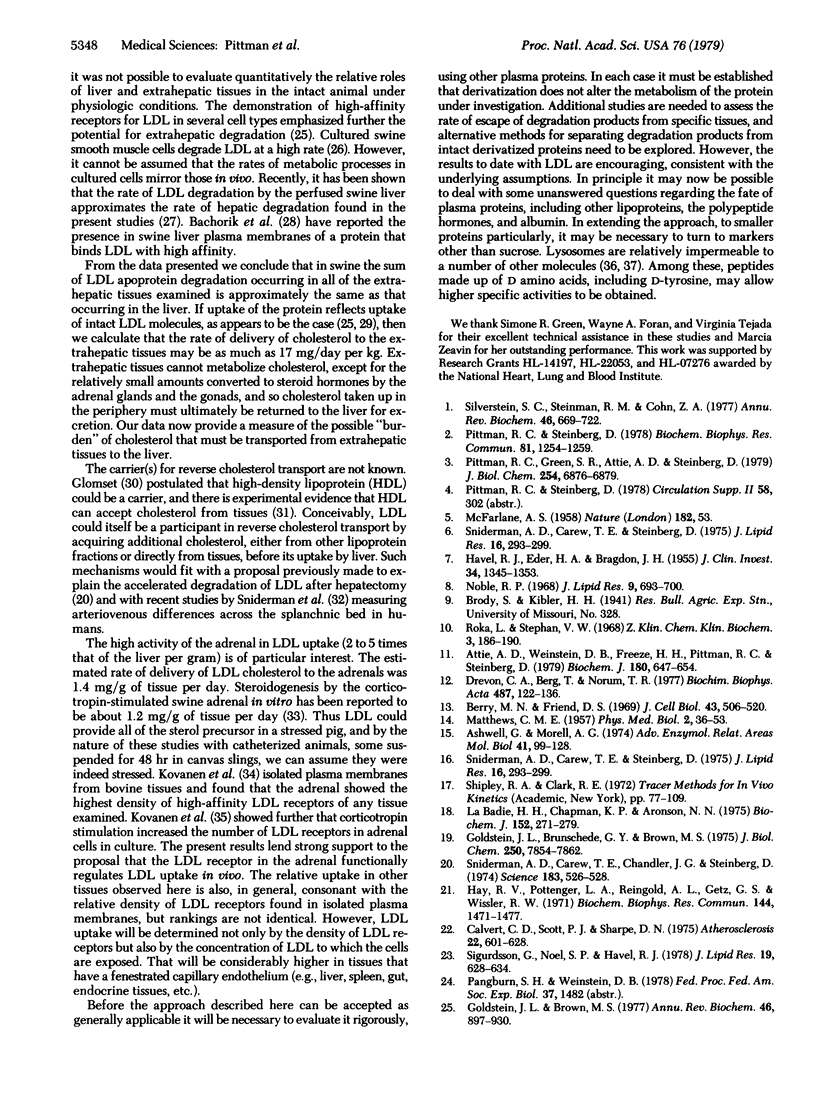Abstract
A method for determining tissue sites of plasma protein degradation is described as applied to studies of low density lipoprotein (LDL) catabolism in swine. The method is based on the fact that sucrose is not degraded by lysosomal enzymes and thus accumulates in lysosomes. [14C]Sucrose was activated with cyanuric chloride and covalently coupled to the LDL protein. Studies in cultured fibroblasts have established that the sucrose 14C accumulates intracellularly in degradation products at a rate equal to the rate of degradation of 125I-labeled LDL simultaneously measured. In vivo the fractional catabolic rate of [14C]sucrose-LDL was the same as that of 125I-labeled LDL. 14C-Labeled degradation products in all major tissues were determined 24 hours after injection of [14C]sucrose-LDL. About 75% of the LDL degraded (calculated from analysis of the plasma decay curve) was accounted for in the 14C-labeled degradation products accumulated in the tissues examined; only 4% appeared in the urine. In three studies, 37.9, 39.6, and 37.8% of the LDL degraded was recovered in the liver. Results were similar at 48 hr (38.7 and 39.9% hepatic degradation), but urinary losses were then about 10% and about 4% was lost in bile. All extrahepatic tissues examined contained 14C-labeled degradation products. The concentration was highest in the adrenal glands—2 to 5 times that in liver and 10 times that in the next most active tissues. In principle this approach should be applicable to studies of the tissue sites of degradation of any of the plasma proteins.
Keywords: lysosomal degradation, apolipoproteins, lipoprotein metabolism, swine
Full text
PDF




Selected References
These references are in PubMed. This may not be the complete list of references from this article.
- Ashwell G., Morell A. G. The role of surface carbohydrates in the hepatic recognition and transport of circulating glycoproteins. Adv Enzymol Relat Areas Mol Biol. 1974;41(0):99–128. doi: 10.1002/9780470122860.ch3. [DOI] [PubMed] [Google Scholar]
- Attie A. D., Weinstein D. B., Freeze H. H., Pittman R. C., Steinberg D. Unaltered catabolism of desialylated low-density lipoprotein in the pig and in cultured rat hepatocytes. Biochem J. 1979 Jun 15;180(3):647–654. doi: 10.1042/bj1800647. [DOI] [PMC free article] [PubMed] [Google Scholar]
- Bachorik P. S., Kwiterovich P. O., Cooke J. C. Isolation of a porcine liver plasma membrane fraction that binds low density lipoproteins. Biochemistry. 1978 Nov 28;17(24):5287–5299. doi: 10.1021/bi00617a032. [DOI] [PubMed] [Google Scholar]
- Berry M. N., Friend D. S. High-yield preparation of isolated rat liver parenchymal cells: a biochemical and fine structural study. J Cell Biol. 1969 Dec;43(3):506–520. doi: 10.1083/jcb.43.3.506. [DOI] [PMC free article] [PubMed] [Google Scholar]
- Calvert G. D., Scott P. J., Sharpe D. N. The plasma and tissue turnover and distribution of two radio-iodine-labelled pig plasma low density lipoproteins. Atherosclerosis. 1975 Nov-Dec;22(3):601–628. doi: 10.1016/0021-9150(75)90037-4. [DOI] [PubMed] [Google Scholar]
- De Duve C., Wattiaux R. Functions of lysosomes. Annu Rev Physiol. 1966;28:435–492. doi: 10.1146/annurev.ph.28.030166.002251. [DOI] [PubMed] [Google Scholar]
- Drevon C. A., Berg T., Norum K. R. Uptake and degradation of cholesterol ester-labelled rat plasma lipoproteins in purified rat hepatocytes and nonparenchymal liver cells. Biochim Biophys Acta. 1977 Apr 26;487(1):122–136. doi: 10.1016/0005-2760(77)90049-2. [DOI] [PubMed] [Google Scholar]
- Dvorák M. Adrenocortical function in foetal, neonatal and young pigs. J Endocrinol. 1972 Sep;54(3):473–481. doi: 10.1677/joe.0.0540473. [DOI] [PubMed] [Google Scholar]
- Glomset J. A. The plasma lecithins:cholesterol acyltransferase reaction. J Lipid Res. 1968 Mar;9(2):155–167. [PubMed] [Google Scholar]
- Goldstein J. L., Brown M. S. The low-density lipoprotein pathway and its relation to atherosclerosis. Annu Rev Biochem. 1977;46:897–930. doi: 10.1146/annurev.bi.46.070177.004341. [DOI] [PubMed] [Google Scholar]
- Goldstein J. L., Brunschede G. Y., Brown M. S. Inhibition of proteolytic degradation of low density lipoprotein in human fibroblasts by chloroquine, concanavalin A, and Triton WR 1339. J Biol Chem. 1975 Oct 10;250(19):7854–7862. [PubMed] [Google Scholar]
- Goldstein J. L., Brunschede G. Y., Brown M. S. Inhibition of proteolytic degradation of low density lipoprotein in human fibroblasts by chloroquine, concanavalin A, and Triton WR 1339. J Biol Chem. 1975 Oct 10;250(19):7854–7862. [PubMed] [Google Scholar]
- HAVEL R. J., EDER H. A., BRAGDON J. H. The distribution and chemical composition of ultracentrifugally separated lipoproteins in human serum. J Clin Invest. 1955 Sep;34(9):1345–1353. doi: 10.1172/JCI103182. [DOI] [PMC free article] [PubMed] [Google Scholar]
- Hay R. V., Pottenger L. A., Reingold A. L., Getz G. S., Wissler R. W. Degradation of I 125 -labelled serum low density lipoprotein in normal and estrogen-treated male rats. Biochem Biophys Res Commun. 1971 Sep 17;44(6):1471–1477. doi: 10.1016/s0006-291x(71)80251-6. [DOI] [PubMed] [Google Scholar]
- Kovanen P. T., Basu S. K., Goldstein J. L., Brown M. S. Low density lipoprotein receptors in bovine adrenal cortex. II. Low density lipoprotein binding to membranes prepared from fresh tissue. Endocrinology. 1979 Mar;104(3):610–616. doi: 10.1210/endo-104-3-610. [DOI] [PubMed] [Google Scholar]
- Kovanen P. T., Faust J. R., Brown M. S., Goldstein J. L. Low density lipoprotein receptors in bovine adrenal cortex. I. Receptor-mediated uptake of low density lipoprotein and utilization of its cholesterol for steroid synthesis in cultured adrenocortical cells. Endocrinology. 1979 Mar;104(3):599–609. doi: 10.1210/endo-104-3-599. [DOI] [PubMed] [Google Scholar]
- LaBadie J. H., Chapman K. P., Aronson N. N., Jr Glycoprotein catabolism in rat liver: Lysosomal digestion of iodinated asialo-fetuin. Biochem J. 1975 Nov;152(2):271–279. doi: 10.1042/bj1520271. [DOI] [PMC free article] [PubMed] [Google Scholar]
- MATTHEWS C. M. The theory of tracer experiments with 131I-labelled plasma proteins. Phys Med Biol. 1957 Jul;2(1):36–53. doi: 10.1088/0031-9155/2/1/305. [DOI] [PubMed] [Google Scholar]
- McFARLANE A. S. Efficient trace-labelling of proteins with iodine. Nature. 1958 Jul 5;182(4627):53–53. doi: 10.1038/182053a0. [DOI] [PubMed] [Google Scholar]
- Noble R. P. Electrophoretic separation of plasma lipoproteins in agarose gel. J Lipid Res. 1968 Nov;9(6):693–700. [PubMed] [Google Scholar]
- Pittman R. C., Green S. R., Attie A. D., Steinberg D. Radiolabeled sucrose covalently linked to protein. A device for quantifying degradation of plasma proteins catabolized by lysosomal mechanisms. J Biol Chem. 1979 Aug 10;254(15):6876–6879. [PubMed] [Google Scholar]
- Pittman R. C., Steinberg D. A new approach for assessing cumulative lysosomal degradation of proteins or other macromolecules. Biochem Biophys Res Commun. 1978 Apr 28;81(4):1254–1259. doi: 10.1016/0006-291x(78)91271-8. [DOI] [PubMed] [Google Scholar]
- Reijngoud D. J., Tager J. M. The permeability properties of the lysosomal membrane. Biochim Biophys Acta. 1977 Nov 14;472(3-4):419–449. doi: 10.1016/0304-4157(77)90005-3. [DOI] [PubMed] [Google Scholar]
- Sigurdsson G., Noel S. P., Havel R. J. Catabolism of the apoprotein of low density lipoproteins by the isolated perfused rat liver. J Lipid Res. 1978 Jul;19(5):628–634. [PubMed] [Google Scholar]
- Silverstein S. C., Steinman R. M., Cohn Z. A. Endocytosis. Annu Rev Biochem. 1977;46:669–722. doi: 10.1146/annurev.bi.46.070177.003321. [DOI] [PubMed] [Google Scholar]
- Sniderman A. D., Carew T. E., Chandler J. G., Steinberg D. Paradoxical increase in rate of catabolism of low-density lipoproteins after hepatectomy. Science. 1974 Feb 8;183(4124):526–528. doi: 10.1126/science.183.4124.526. [DOI] [PubMed] [Google Scholar]
- Sniderman A. D., Carew T. E., Steinberg D. Turnover and tissue distribution of 125-I-labeled low density lipoprotein in swine and dogs. J Lipid Res. 1975 Jul;16(4):293–299. [PubMed] [Google Scholar]
- Sniderman A. D., Carew T. E., Steinberg D. Turnover and tissue distribution of 125-I-labeled low density lipoprotein in swine and dogs. J Lipid Res. 1975 Jul;16(4):293–299. [PubMed] [Google Scholar]
- Sniderman A., Thomas D., Marpole D., Teng B. Low density lipoprotein. A metabolic pathway for return of cholesterol to the splanchnic bed. J Clin Invest. 1978 Apr;61(4):867–873. doi: 10.1172/JCI109012. [DOI] [PMC free article] [PubMed] [Google Scholar]
- Stein Y., Glangeaud M. C., Fainaru M., Stein O. The removal of cholesterol from aortic smooth muscle cells in culture and Landschutz ascites cells by fractions of human high-density apolipoprotein. Biochim Biophys Acta. 1975 Jan 24;380(1):106–118. doi: 10.1016/0005-2760(75)90049-1. [DOI] [PubMed] [Google Scholar]
- Stephan W., Róka L. Adsorption von Lipoproteiden. Behandlung von Seren mit Adsorbentien. I. Z Klin Chem Klin Biochem. 1968 May;6(3):186–190. [PubMed] [Google Scholar]
- Weinstein D. B., Carew T. E., Steinberg D. Uptake and degradation of low density lipoprotein by swine arterial smoot muscle cells with inhibition of cholesterol biosynthesis. Biochim Biophys Acta. 1976 Mar 26;424(3):404–421. doi: 10.1016/0005-2760(76)90030-8. [DOI] [PubMed] [Google Scholar]


